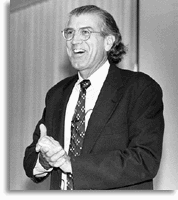 A high-tech slide show provided an overview of services offered by the
center, as well as a look at the technologies being developed in the center
in Kimball Tower on UB's South Campus.
A high-tech slide show provided an overview of services offered by the
center, as well as a look at the technologies being developed in the center
in Kimball Tower on UB's South Campus. 
 A high-tech slide show provided an overview of services offered by the
center, as well as a look at the technologies being developed in the center
in Kimball Tower on UB's South Campus.
A high-tech slide show provided an overview of services offered by the
center, as well as a look at the technologies being developed in the center
in Kimball Tower on UB's South Campus.
Assistive technology, Mann explained, is work that takes any product or piece of equipment and modifies or customizes it so that when it is used, the item increases, maintains or improves the functional abilities of people with disabilities.
Mann offered numerous examples of common and not-so-common devices and equipment that have been adapted to fit individual needs. Some have proved valuable to clients, Mann said, although not always for the reasons their developers expected. A few, he admitted, are "over-engineered" and too expensive or specialized to be of practical use.
But for persons who need help withdaily livingeating, dressing, walkingeven small changes are very important.
For example, Mann said, the walker has been in existence for 100 years. But modifications can make a world of difference for some users. A walker that the Center for Assistive Technology put together "has a lot of features not available on the first walker," he noted, including wheels, brakes, a basket and a tray that can be removed so the walker can be used to sit on. The center gave this walker to a woman in a nursing home; it was so well-received that six months later, 15 other residents were using the same model.
Not all assistive devices are as successful. Mann showed a slide of a powered wheelchair that had been adapted so the seat opened up and the chair could be positioned over a commode "for people who are having problems toileting." But the modification didn't work well, he said. At a cost of $20,000 each, the wheelchair was an "over-engineered device. It didn't sell and I don't believe it's on the market."
Mobility is not the only focus of the center's work. For its vision-impaired clients, the Center for Assistive Technology developed a magnifier that can be used hands-free and has a built-in high-intensity light. The advantage of the device, Mann said, is not just the power of the magnification, "it's the amount of light the person has on the task they're doing."
The center offers a number of devices designed to assist people with their daily tasks. Researchers have modified telephones to provide the visually-impaired with auditory feedback on the number they're dialing. They have modified laptop computers to display information in braille. For the hearing-impaired, there is a device called "quiet wake," which can be placed under a pillow and vibrates to awaken the user; it can be tied in to fire alarms and telephones as well as alarm clocks, Mann said.
The center also has modified television remote controls with surprising results. The prototypes featured large buttons and good color contrast, but were big and bulky, which designers thought clients would dislike. But the devices were well received. "I won't lose it," was the most common reaction to the oversized remote-control devices, Mann said.
"We didn't design it to be big, but we discovered that losing the remote is one of the concerns of clients," Mann said.
There also are assistive devices for people with memory or cognitive impairments. Medicine dispensers can be tied in to the telephone to remind people when it's time to take their prescriptions. And "there are a number of devices that can alert a caregiver if a person wanders off," Mann said.
The Center for Assistive Technology, Mann said, offers tours of its facilities, which include an electronics lab, a fabrication shop and a small model house equipped with assistive devices to be tried out.
The center also provides evaluations of home environments. "How we design our environments and modify them is important and the focus of our work," Mann said. The center works with the School of Architecture and Planning to help clients make adjustments to their living space.
While the center designs devices for people of all ages with disabilities, the majority of the center's focus is on devices to assist the aging. Mann noted that between1970 and 1990, the number of people ages 85 and older doubled, and that that age group is expected to continue to expand. "The highest number of disabled is in the population over age 85," he said. "The impact on the quality of life can be dramatic with assistive devices."
UB at Sunrise is a series of breakfast programs produced by the UB Alumni Association and UB's Office of Conferences and Special Events, News Services and Office of Publications. It also is supported by the Office of University Development and the Office of Public Service and Urban Affairs. The Buffalo Marriott is corporate sponsor.
PHOTO BY NANCY J. PARISI